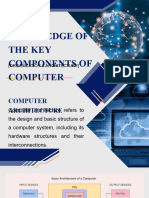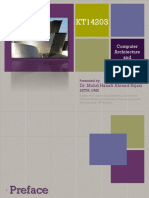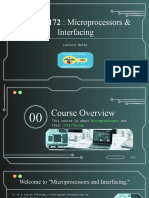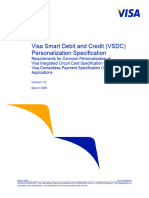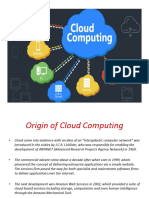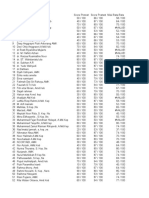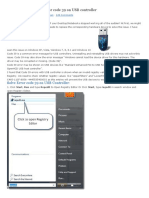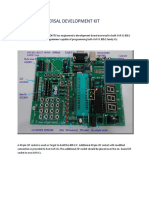Sandeep - Notes JavaDsa Handwritten Notes
Uploaded by
mainak1331senSandeep - Notes JavaDsa Handwritten Notes
Uploaded by
mainak1331senlOMoARcPSD|41922568
COA 21 PPT unit 2 - ppt
Computer Organization and Architecture (SRM Institute of Science and Technology)
Scan to open on Studocu
Studocu is not sponsored or endorsed by any college or university
Downloaded by Mainak Sen (mainak1331sen@gmail.com)
lOMoARcPSD|41922568
21CSS201T
COMPUTER ORGANIZATION
AND ARCHITECTURE
UNIT-2
Topic : Basic Structure of a
Computer
25-08-2023 21CSS201T - Computer Organization and Architecture 1
Downloaded by Mainak Sen (mainak1331sen@gmail.com)
lOMoARcPSD|41922568
Basic Structure of Computers
Computer Architecture in general covers three aspects of computer design namely:
Computer Hardware, Instruction set Architecture and Computer Organization.
Computer hardware consists of electronic circuits, displays, magnetic and optical
storage media and communication facilities.
Instruction set Architecture is programmer visible machine interface such as
instruction set, registers, memory organization and exception handling. Two main
approaches are mainly CISC (Complex Instruction Set Computer) and RISC
(Reduced Instruction Set Computer)
Computer Organization includes the high level aspects of a design, such as memory
system, the bus structure and the design of the internal CPU.
25-08-2023 21CSS201T - Computer Organization and Architecture 2
Downloaded by Mainak Sen (mainak1331sen@gmail.com)
lOMoARcPSD|41922568
Computer Types
Computer is a fast electronic calculating machine which accepts digital input,
processes it according to the internally stored instructions (Programs) and produces
the result on the output device. The internal operation of the computer can be as
depicted in the figure below:
25-08-2023 21CSS201T - Computer Organization and Architecture 3
Downloaded by Mainak Sen (mainak1331sen@gmail.com)
lOMoARcPSD|41922568
Computer Types – contd.
The computers can be classified into various categoriesas given below:
Micro Computer
Laptop Computer
Work Station
Super Computer
Main Frame
Hand Held
Multi core
25-08-2023 21CSS201T - Computer Organization and Architecture 4
Downloaded by Mainak Sen (mainak1331sen@gmail.com)
lOMoARcPSD|41922568
Computer Types – contd.
Micro Computer: A personal computer; designed to meet the computer needs of
an individual. Provides access to a wide variety of computing applications, such as
word processing, photo editing, e-mail, and internet.
Laptop Computer: A portable, compact computer that can run on power supply or
a battery unit. All components are integrated as one compact unit. It is generally
more expensive than a comparable desktop. It is also called a Notebook.
Work Station: Powerful desktop computer designed for specialized tasks.
Generally used for tasks that requires a lot of processing speed. Can also be an
ordinary personal computer attached to a LAN (local area network).
25-08-2023 21CSS201T - Computer Organization and Architecture 5
Downloaded by Mainak Sen (mainak1331sen@gmail.com)
lOMoARcPSD|41922568
Computer Types – contd.
Super Computer: A computer that is considered to be fastest in the world. Used to execute
tasks that would take lot of time for other computers. For Ex: Modeling weather systems,
genome sequence, etc (Refer site: http://www.top500.org/)
Main Frame: Large expensive computer capable of simultaneously processing data for
hundreds or thousands of users. Used to store, manage, and process large amounts of data
that need to be reliable, secure, and centralized.
Hand Held: It is also called a PDA (Personal Digital Assistant). A computer that fits into a
pocket, runs on batteries, and is used while holding the unit in your hand. Typically used as
an appointment book, address book, calculator and notepad.
Multi Core: Have Multiple Cores – parallel computing platforms. Many Cores or computing
elements in a single chip. Typical Examples: Sony Play station, Core 2 Duo, i3, i7 etc.
25-08-2023 21CSS201T - Computer Organization and Architecture 6
Downloaded by Mainak Sen (mainak1331sen@gmail.com)
lOMoARcPSD|41922568
25-08-2023 21CSS201T - Computer Organization and Architecture 7
Downloaded by Mainak Sen (mainak1331sen@gmail.com)
lOMoARcPSD|41922568
FUNCTIONAL UNITS OF COMPUTER
• Input Unit
• Output Unit
• Central processing Unit (ALU and Control Units)
• Memory
• Bus Structure
25-08-2023 21CSS201T - Computer Organization and Architecture 8
Downloaded by Mainak Sen (mainak1331sen@gmail.com)
lOMoARcPSD|41922568
25-08-2023 21CSS201T - Computer Organization and Architecture 9
Downloaded by Mainak Sen (mainak1331sen@gmail.com)
lOMoARcPSD|41922568
What is a computer?
• a computer is a sophisticated electronic calculating machine
that:
– Accepts input information,
– Processes the information according to a list of internally
stored instructions and
– Produces the resulting output information.
• Functions performed by a computer are:
– Accepting information to be processed as input.
– Storing a list of instructions to process the information.
– Processing the information according to the list of
instructions.
– Providing the results of the processing as output.
• What are the functional units of a computer? 6
25-08-2023 21CSS201T - Computer Organization and Architecture 10
Downloaded by Mainak Sen (mainak1331sen@gmail.com)
lOMoARcPSD|41922568
Functions
• ALL computer functions are:
– Data PROCESSING
– Data STORAGE Data =
– Data MOVEMENT Information
– CONTROL Coordinates How
Information is Used
25-08-2023 21CSS201T - Computer Organization and Architecture 11
Downloaded by Mainak Sen (mainak1331sen@gmail.com)
lOMoARcPSD|41922568
Functions of a computer
The operations performed by a computer using the functional units
can be summarized as follows:
• It accepts information (program and data) through input unit and
transfers it to the memory.
• Information stored in the memory is fetched, under program
control, into an arithmetic and logic unit for processing.
• Processed information leaves the computer through an output
unit.
• The control unit controls all activities taking place inside a
computer.
25-08-2023 21CSS201T - Computer Organization and Architecture 12
Downloaded by Mainak Sen (mainak1331sen@gmail.com)
lOMoARcPSD|41922568
25-08-2023 21CSS201T - Computer Organization and Architecture 13
Downloaded by Mainak Sen (mainak1331sen@gmail.com)
lOMoARcPSD|41922568
Arithmetic and Logic Unit (ALU)
• Operations are executed in the Arithmetic
and Logic Unit (ALU).
– Arithmetic operations such as addition, subtraction.
– Logic operations such as comparison of numbers.
• In order to execute an instruction, operands need
to be brought into the ALU from the memory.
– Operands are stored in general purpose registers available in the ALU.
– Access times of general purpose registers are faster than the cache.
• Results of the operations are stored back in the
memory or retained in the processor for
immediate use.
25-08-2023 21CSS201T - Computer Organization
14 and Architecture 14
Downloaded by Mainak Sen (mainak1331sen@gmail.com)
lOMoARcPSD|41922568
Output unit
• Computers represent information in a specific binary form. Output units:
- Interface with output devices.
- Accept processed results provided by the computer in specific binary form.
- Convert the information in binary form to a form understood by
an output device.
25-08-2023 21CSS201T - Computer Organization
15 and Architecture 15
Downloaded by Mainak Sen (mainak1331sen@gmail.com)
lOMoARcPSD|41922568
Control unit
• Operation of a computer can be summarized as:
– Accepts information from the input units (Input unit).
– Stores the information (Memory).
– Processes the information (ALU).
– Provides processed results through the output units (Output
unit).
• Operations of Input unit, Memory, ALU and Output unit are
coordinated by Control unit.
• Instructions control “what” operations take place (e.g. data transfer,
processing).
• Control unit generates timing signals which determines “when” a
particular operation takes place.
25-08-2023 21CSS201T - Computer Organization
16 and Architecture 16
Downloaded by Mainak Sen (mainak1331sen@gmail.com)
lOMoARcPSD|41922568
CPU (Central processing Unit)
•The “brain” of the machine
•Responsible for carrying out computational task
•Contains ALU, CU, Registers
•ALU Performs Arithmetic and logical operations
•CU Provides control signals in accordance with some timings which in turn
controls the execution process
•Register Stores data and result and speeds up the operation
25-08-2023 21CSS201T - Computer Organization and Architecture 17
Downloaded by Mainak Sen (mainak1331sen@gmail.com)
lOMoARcPSD|41922568
CONTROL UNIT
• Control unit works with a
reference signal called
T1 Processor clock
T2 • Processor divides the
operations into basic steps
• Each basic step is
R1 R2 executed in one clock
cycle
R2
25-08-2023 21CSS201T - Computer Organization and Architecture 18
Downloaded by Mainak Sen (mainak1331sen@gmail.com)
lOMoARcPSD|41922568
Example
Add R1, R2
T1 Enable R1
T2 Enable R2
T3 Enable ALU for addition operation
T4 Enable out put of ALU to store result of the
operation
25-08-2023 21CSS201T - Computer Organization and Architecture 19
Downloaded by Mainak Sen (mainak1331sen@gmail.com)
lOMoARcPSD|41922568
25-08-2023 21CSS201T - Computer Organization and Architecture 20
Downloaded by Mainak Sen (mainak1331sen@gmail.com)
lOMoARcPSD|41922568
25-08-2023 21CSS201T - Computer Organization and Architecture 21
Downloaded by Mainak Sen (mainak1331sen@gmail.com)
lOMoARcPSD|41922568
25-08-2023 21CSS201T - Computer Organization and Architecture 22
Downloaded by Mainak Sen (mainak1331sen@gmail.com)
lOMoARcPSD|41922568
25-08-2023 21CSS201T - Computer Organization and Architecture 23
Downloaded by Mainak Sen (mainak1331sen@gmail.com)
lOMoARcPSD|41922568
25-08-2023 21CSS201T - Computer Organization and Architecture 24
Downloaded by Mainak Sen (mainak1331sen@gmail.com)
lOMoARcPSD|41922568
25-08-2023 21CSS201T - Computer Organization and Architecture 25
Downloaded by Mainak Sen (mainak1331sen@gmail.com)
lOMoARcPSD|41922568
Registers
Registers are fast stand-alone storage locations that hold data temporarily. Multiple registers are
needed to facilitate the operation of the CPU. Some of these registers are
Two registers-MAR (Memory Address Register) and MDR (Memory
Data Register) : To handle the data transfer between main memory
and processor. MAR-Holds addresses, MDR-Holds data
Instruction register (IR) : Hold the Instructions that is currently
being executed
Program counter (PC) : Points to the next instructions that is to be
fetched from memory
General-purpose Registers: are used for holding data, intermediate
results of operations. They are also known as scratch-pad registers.
25-08-2023 21CSS201T - Computer Organization and Architecture 26
Downloaded by Mainak Sen (mainak1331sen@gmail.com)
lOMoARcPSD|41922568
25-08-2023 21CSS201T - Computer Organization and Architecture 27
Downloaded by Mainak Sen (mainak1331sen@gmail.com)
lOMoARcPSD|41922568
25-08-2023 21CSS201T - Computer Organization and Architecture 28
Downloaded by Mainak Sen (mainak1331sen@gmail.com)
lOMoARcPSD|41922568
25-08-2023 21CSS201T - Computer Organization and Architecture 29
Downloaded by Mainak Sen (mainak1331sen@gmail.com)
lOMoARcPSD|41922568
25-08-2023 21CSS201T - Computer Organization and Architecture 30
Downloaded by Mainak Sen (mainak1331sen@gmail.com)
lOMoARcPSD|41922568
25-08-2023 21CSS201T - Computer Organization and Architecture 31
Downloaded by Mainak Sen (mainak1331sen@gmail.com)
lOMoARcPSD|41922568
Bus Structures
25-08-2023 21CSS201T - Computer Organization and Architecture 32
Downloaded by Mainak Sen (mainak1331sen@gmail.com)
lOMoARcPSD|41922568
Connecting CPU and memory
The CPU and memory are normally connected by three
groups of connections, each called a bus: data bus, address
bus and control bus
Connecting CPU and memory using three buses
25-08-2023 21CSS201T - Computer Organization and Architecture 33
Downloaded by Mainak Sen (mainak1331sen@gmail.com)
lOMoARcPSD|41922568
BUS STRUCTURE
•Group of wires which carries information form CPU to peripherals or vice –
versa
•Single bus structure: Common bus used to communicate between
peripherals and microprocessor
INPUT MEMORY PROCESSOR OUTPUT
Single Bus Structure
25-08-2023 21CSS201T - Computer Organization and Architecture 34
Downloaded by Mainak Sen (mainak1331sen@gmail.com)
lOMoARcPSD|41922568
Drawbacks of the Single Bus Structure
• The devices connected to a bus vary widely in their speed of
operation.
• Some devices are relatively slow, such as printer and keyboard.
• Some devices are considerably fast, such as optical disks.
• Memory and processor units operate are the fastest parts of a
computer.
• Efficient transfer mechanism thus is needed to cope with this
problem.
• A common approach is to include buffer registers with the
devices to hold the information during transfers .
• An another approach is to use two-bus structure and an
additional transfer mechanism
25-08-2023 21CSS201T - Computer Organization and Architecture 35
Downloaded by Mainak Sen (mainak1331sen@gmail.com)
lOMoARcPSD|41922568
TWO BUS STRUCTURE:
• One bus can be used to fetch instruction other can be used to
fetch data, required for execution.
•The bus is said to perform two distinct functions
•The main advantage of this structure is good operating speed
but on account of more cost.
25-08-2023 21CSS201T - Computer Organization and Architecture 36
Downloaded by Mainak Sen (mainak1331sen@gmail.com)
lOMoARcPSD|41922568
MULTI BUS STRUCTURE
To improve performance multi bus structure can be used.
CONTROL BUS A2 A1 A0 Selected
location
0 0 0 0th
Location
0 0 1 1st Location
0 1 0
W/R
CS RD
A0 PROCESSOR
0 1 1
A1
A2 1 0 0
ADDRESS BUS 1 0 1
D7 D0 1 1 0
D0 D7
1 1 1
DATA BUS
25-08-2023 21CSS201T - Computer Organization and Architecture 37
Downloaded by Mainak Sen (mainak1331sen@gmail.com)
lOMoARcPSD|41922568
•23 = 8 i.e. 3 address line is required to select 8 location
•In general 2x = n where x number of address lines (address bit) and
n is number of location
•Address bus : unidirectional : group of wires which carries
address information bits form processor to peripherals (16,20,24 or
more parallel signal lines)
•Data bus: bidirectional : group of wires which carries data
information bit form processor to peripherals and vice – versa
•Control bus: bidirectional: group of wires which carries control
signals form processor to peripherals and vice – versa
25-08-2023 21CSS201T - Computer Organization and Architecture 38
Downloaded by Mainak Sen (mainak1331sen@gmail.com)
lOMoARcPSD|41922568
Figure below shows address, data and control bus and their connection with
peripheral and microprocessor
25-08-2023 21CSS201T - Computer Organization and Architecture 39
Downloaded by Mainak Sen (mainak1331sen@gmail.com)
lOMoARcPSD|41922568
Memory Locations and Addresses
25-08-2023 21CSS201T - Computer Organization and Architecture 40
Downloaded by Mainak Sen (mainak1331sen@gmail.com)
lOMoARcPSD|41922568
MEMORY HIERARCHY
Memory Hierarchy is to obtain the highest possible
access speed while minimizing the total cost of the memory system
25-08-2023 21CSS201T - Computer Organization and Architecture 41
Downloaded by Mainak Sen (mainak1331sen@gmail.com)
lOMoARcPSD|41922568
Memory Locations and Addresses
Memory consists of many millions n bits
of storage cells, each of which can
first word
second word
store 1 bit.
•
Data is usually accessed in n-bit •
•
groups. n is called word length. i th word
The memory of a computer can be •
schematically represented as a •
•
collection of words as shown in last word
Figure 1. Figure 1 Main Memory words.
25-08-2023 21CSS201T - Computer Organization and Architecture 42
Downloaded by Mainak Sen (mainak1331sen@gmail.com)
lOMoARcPSD|41922568
MEMORY LOCATIONS AND ADDRESSES
•Main memory is the second major subsystem in a computer. It consists of a collection of
storage locations, each with a unique identifier, called an address.
•Data is transferred to and from memory in groups of bits called words. A word can be a
group of 8 bits, 16 bits, 32 bits or 64 bits (and growing).
•If the word is 8 bits, it is referred to as a byte. The term “byte” is so common in computer
science that sometimes a 16-bit word is referred to as a 2-byte word, or a 32-bit word is
referred to as a 4-byte word.
25-08-2023 21CSS201T - Computer Organization and Architecture 43
Downloaded by Mainak Sen (mainak1331sen@gmail.com)
lOMoARcPSD|41922568
Main memory
25-08-2023 21CSS201T - Computer Organization and Architecture 44
Downloaded by Mainak Sen (mainak1331sen@gmail.com)
lOMoARcPSD|41922568
25-08-2023 21CSS201T - Computer Organization and Architecture 45
Downloaded by Mainak Sen (mainak1331sen@gmail.com)
lOMoARcPSD|41922568
Address space
•To access a word in memory requires an identifier. Although programmers use a name to
identify a word (or a collection of words), at the hardware level each word is identified by
an address.
•The total number of uniquely identifiable locations in memory is called the address
space.
•For example, a memory with 64 kilobytes (16 address line required) and a word size of 1
byte has an address space that ranges from 0 to 65,535.
25-08-2023 21CSS201T - Computer Organization and Architecture 46
Downloaded by Mainak Sen (mainak1331sen@gmail.com)
lOMoARcPSD|41922568
Memory addresses are defined using unsigned
binary integers.
25-08-2023 21CSS201T - Computer Organization and Architecture 47
Downloaded by Mainak Sen (mainak1331sen@gmail.com)
lOMoARcPSD|41922568
Example 1
A computer has 32 MB (megabytes) of memory. How many bits are needed to address any
single byte in memory?
Solution
The memory address space is 32 MB, or 225 (25 × 220). This means that we need log2 225, or 25
bits, to address each byte.
Example 2
A computer has 128 MB of memory. Each word in this computer is eight bytes. How many bits
are needed to address any single word in memory?
Solution
The memory address space is 128 MB, which means 227. However, each word is eight (23)
bytes, which means that we have 224 words. This means that we need log2 224, or 24 bits, to
address each word.
25-08-2023 21CSS201T - Computer Organization and Architecture 48
Downloaded by Mainak Sen (mainak1331sen@gmail.com)
lOMoARcPSD|41922568
MEMORY OPERATIONS
• Today, general-purpose computers use a set of instructions called a program to
process data.
• A computer executes the program to create output data from input data
• Both program instructions and data operands are stored in memory
• Two basic operations requires in memory access
• Load operation (Read or Fetch)-Contents of specified memory location are read by
processor
• Store operation (Write)- Data from the processor is stored in specified memory location
25-08-2023 21CSS201T - Computer Organization and Architecture 49
Downloaded by Mainak Sen (mainak1331sen@gmail.com)
lOMoARcPSD|41922568
Assignment of Byte Address
• Big-endian and little-endian are terms that describe the order in which a
sequence of bytes are stored in computer memory.
• Big-endian is an order in which the "bigend" (most significant value in
the sequence) is stored first (at the lowest storage address).
• Little-endian is an order in which the “Little end" (least significant value
in the sequence) is stored first (at the lowest storage address).
25-08-2023 21CSS201T - Computer Organization and Architecture 50
Downloaded by Mainak Sen (mainak1331sen@gmail.com)
lOMoARcPSD|41922568
25-08-2023 21CSS201T - Computer Organization and Architecture 51
Downloaded by Mainak Sen (mainak1331sen@gmail.com)
lOMoARcPSD|41922568
Assignment of byte addresses
• Little Endian (e.g., in DEC, Intel)
» low order byte stored at lowest address
» byte0 byte1 byte2 byte3
• Eg: 46,78,96,54 (32 bit data)
• H BYTE L BYTE
54
• 8000 96
• 8001 78
• 8002 46
• 8003
• 8004 |
25-08-2023 21CSS201T - Computer Organization and Architecture 52
Downloaded by Mainak Sen (mainak1331sen@gmail.com)
lOMoARcPSD|41922568
Big Endian
• Big Endian (e.g., in IBM, Motorolla, Sun, HP)
» high order byte stored at lowest address
» byte3 byte2 byte1 byte0
• Programmers/protocols should be careful when transferring binary data
between Big Endian and Little Endian machines
25-08-2023 21CSS201T - Computer Organization and Architecture 53
Downloaded by Mainak Sen (mainak1331sen@gmail.com)
lOMoARcPSD|41922568
Big-Endian and Little-Endian Assignments
Big-Endian: lower byte addresses are used for the most significant bytes of the word
Little-Endian: opposite ordering. lower byte addresses are used for the less significant bytes of the word
W ord
address Byte address Byte address
0 0 1 2 3 0 3 2 1 0
4 4 5 6 7 4 7 6 5 4
• •
• •
• •
k k k k k k k k k k
2 - 4 2 - 4 2 - 3 2 - 2 2 - 1 2 - 4 2 - 1 2 - 2 2 - 3 2 - 4
25-08-2023 (a) Big-endian assignment (b) Little-endian assignment
21CSS201T - Computer Organization and Architecture 54
Byte and word addressing.
Downloaded by Mainak Sen (mainak1331sen@gmail.com)
lOMoARcPSD|41922568
• In case of 16 bit data, aligned words begin at byte addresses of
0,2,4,………………………….
• In case of 32 bit data, aligned words begin at byte address of
0,4,8,………………………….
• In case of 64 bit data, aligned words begin at byte addresses of
0,8,16,………………………..
• In some cases words can start at an arbitrary byte address also then, we say
that word locations are unaligned
25-08-2023 21CSS201T - Computer Organization and Architecture 55
Downloaded by Mainak Sen (mainak1331sen@gmail.com)
lOMoARcPSD|41922568
Instruction and instruction
sequencing
25-08-2023 21CSS201T - Computer Organization and Architecture 56
Downloaded by Mainak Sen (mainak1331sen@gmail.com)
lOMoARcPSD|41922568
• Instruction: is command to the microprocessor to perform a given
task on specified data.
• Instruction Set: The entire group of these instructions are called
instruction set.
• instruction sequencing : The order in which the instructions in a
program are carried out.
4 TYPES OF OPERATION:-
A computer must have instructions capable of performing 4 types of
operation
• Data transfer between memory and processor register
• Arithmetic and logic operation
• Program sequencing and control
• I/O transfer
25-08-2023 21CSS201T - Computer Organization and Architecture 57
Downloaded by Mainak Sen (mainak1331sen@gmail.com)
lOMoARcPSD|41922568
Register transfer notation (RTN)
Transfer between processor registers & memory, between processor
register & I/O devices
Memory locations, registers and I/O register names are identified by
a symbolic name in uppercase alphabets
• LOC,PLACE,MEM are the address of memory location
• R1 , R2,… are processor registers
• DATA_IN, DATA_OUT are I/O registers
• Contents of location is indicated by using square brackets [ ]
• RHS of RTN always denotes a values, and is called Source
• LHS of RTN always denotes a symbolic name where value is to
be stored and is called destination
• Source contents are not modified
25-08-2023
• Destination contents are overwritten
21CSS201T - Computer Organization and Architecture 58
Downloaded by Mainak Sen (mainak1331sen@gmail.com)
lOMoARcPSD|41922568
Examples of RTN statements
• R2 [LOCN]
• R4 [R3] +[R2]
25-08-2023 21CSS201T - Computer Organization and Architecture 59
Downloaded by Mainak Sen (mainak1331sen@gmail.com)
lOMoARcPSD|41922568
Data transfer Instructions
They are also called copy instructions.
Some instructions in 8086:
MOV -Copy from the source to the destination
LDA - Load the accumulator
STA - Store the accumulator
PUSH - Push the register pair onto the stack
POP - Pop off stack to the register pair
25-08-2023 21CSS201T - Computer Organization and Architecture 60
Downloaded by Mainak Sen (mainak1331sen@gmail.com)
lOMoARcPSD|41922568
Data Manipulation Instructions
• To perform the operations by the ALU
• Three categories:
• Arithmetic Instructions
• Logical and bit manipulation instructions
• Shift instructions
25-08-2023 21CSS201T - Computer Organization and Architecture 61
Downloaded by Mainak Sen (mainak1331sen@gmail.com)
lOMoARcPSD|41922568
Arithmetic Instructions
Used to perform arithmetic operations
Some instruction in 8086
INC Increment the data by 1
DEC Decreases data by 1
ADD perform sum of data
ADC Add with carry bit.
MUL perform multiplication
25-08-2023 21CSS201T - Computer Organization and Architecture 62
Downloaded by Mainak Sen (mainak1331sen@gmail.com)
lOMoARcPSD|41922568
Logical and bit manipulation instructions
Used to perform logical operations
Some instructions are:
AND bitwise AND operation
OR bitwise AND operation
NOT invert each bit of a byte or word
XOR Exclusive-OR operation over each bit
25-08-2023 21CSS201T - Computer Organization and Architecture 63
Downloaded by Mainak Sen (mainak1331sen@gmail.com)
lOMoARcPSD|41922568
Shift instructions
used for shifting or rotating the contents of the register
Some instructions are:
SHR shift bits towards the right and put zero(S) in
MSBs
ROL rotate bits towards the left, i.e. MSB to LSB
and to Carry Flag [CF]
RCL rotate bits towards the left, i.e. MSB to CF and
CF to LSB.
25-08-2023 21CSS201T - Computer Organization and Architecture 64
Downloaded by Mainak Sen (mainak1331sen@gmail.com)
lOMoARcPSD|41922568
Instruction Formats
(Types of instruction based on the address field)
• A instruction in computer comprises of groups called
fields.
• These field contains different information
• The most common fields are:
Operation field : specifies the operation to be
performed like addition.
Address field : contain the location of
operand
Mode field : specifies how to find the operand
25-08-2023 21CSS201T - Computer Organization and Architecture 65
Downloaded by Mainak Sen (mainak1331sen@gmail.com)
lOMoARcPSD|41922568
• A instruction is of various length depending upon the number of
addresses it contain.
• On the basis of number of address, instruction are classified as:
• Zero Address Instructions
• One Address Instructions
• Two Address Instructions
• Three Address Instructions
25-08-2023 21CSS201T - Computer Organization and Architecture 66
Downloaded by Mainak Sen (mainak1331sen@gmail.com)
lOMoARcPSD|41922568
Zero Address Instructions
Used in stack based computers which do not use address field in
instruction
• Location of all operands are defined implicitly
• Operands are stored in a structure called pushdown stack
Operation
25-08-2023 21CSS201T - Computer Organization and Architecture 67
Downloaded by Mainak Sen (mainak1331sen@gmail.com)
lOMoARcPSD|41922568
If processor supports ALU operations one data in memory and other in register
then the instruction sequence is
• MOVE D, Ri
• ADD E, Ri
• MOVE Ri, F
If processor supports ALU operations only with registers then one has to follow
the instruction sequence given below
• LOAD D, Ri
• LOAD E, Rj
• ADD Ri, Rj
• MOVE Rj, F
25-08-2023 21CSS201T - Computer Organization and Architecture 68
Downloaded by Mainak Sen (mainak1331sen@gmail.com)
lOMoARcPSD|41922568
Example: Evaluate (A+B) (C+D)
• Using Zero-Address instruction
1. PUSH A ; TOS ← A
2. PUSH B ; TOS ← B
3. ADD ; TOS ← (A + B)
4. PUSH C ; TOS ← C
5. PUSH D ; TOS ← D
6. ADD ; TOS ← (C + D)
7. MUL ; TOS ← (C+D)(A+B)
8. POP X ; M[X] ← TOS
25-08-2023 21CSS201T - Computer Organization and Architecture 69
Downloaded by Mainak Sen (mainak1331sen@gmail.com)
lOMoARcPSD|41922568
One address Instruction
• Syntax- Operation source/destination
• In this type either a source or destination operand is mentioned in
the instruction
• Other operand is implied to be a processor register called
Accumulator
• Eg: ADD B (general)
• Load D; ACC [memlocation _D]
• ADD E; ACC (ACC) +(E)
• STORE F; memlocation_ F (ACC )
25-08-2023 21CSS201T - Computer Organization and Architecture 70
Downloaded by Mainak Sen (mainak1331sen@gmail.com)
lOMoARcPSD|41922568
One address Instruction
• This use a implied ACCUMULATOR register for data manipulation.
Operation Destination
• One operand is in accumulator and other is in register or memory location.
Example: Evaluate (A+B) (C+D)
• Using One-Address Instruction
1. LOAD A ; AC ← M[A]
2. ADD B ; AC ← AC + M[B]
3. STORE T ; M[T] ← AC
4. LOAD C ; AC ← M[C]
5. ADD D ; AC ← AC + M[D]
6. MUL T ; AC ← AC M[T]
7. STORE X ; M[X] ← AC
25-08-2023 21CSS201T - Computer Organization and Architecture 71
Downloaded by Mainak Sen (mainak1331sen@gmail.com)
lOMoARcPSD|41922568
Two Address Instruction
•Syntax : Operation source, destination
•Eg: MOVE E,F MOVE D,F
ADD D,F OR ADD E,F
Perform ADD A,B,C using 2 instructions
MOVE B,C
ADD A,C
Disadvantage: Single instruction is not sufficient to perform
the entire operation.
25-08-2023 21CSS201T - Computer Organization and Architecture 72
Downloaded by Mainak Sen (mainak1331sen@gmail.com)
lOMoARcPSD|41922568
Two Address Instruction
This is common in commercial computers.
Operation Source, Destination
Here two address can be specified in the instruction.
Example: Evaluate (A+B) (C+D)
Using Two address Instruction:
1. MOV R1,A ; R1=M[A]
2. ADD R1,B ;R1=R1+M[B]
3. MOV R2,C ;R2=M[C]
4. ADD R2,D ;R2=R2+M[D]
5. MUL R1,R2 ; R1=R1*R2
25-08-2023
6. MOV X,R1 21CSS201T - Computer Organization and Architecture
; M[X]=R1 73
Downloaded by Mainak Sen (mainak1331sen@gmail.com)
lOMoARcPSD|41922568
Three Address Instruction
•Syntax: Operation source 1, source 2, destination
•Eg: ADD D,E,F
where D,E,F are memory location
•Advantage: Single instruction can perform the complete
operation
•Disadvantage : Instruction code will be too large to fit in
one word location in memory
25-08-2023 21CSS201T - Computer Organization and Architecture 74
Downloaded by Mainak Sen (mainak1331sen@gmail.com)
lOMoARcPSD|41922568
Three Address Instruction
This has three address field to specify a register or a memory
location.
Program created are much short in size
creation of program much easier
does not mean that program will run much faster
Example: Evaluate (A+B) (C+D)
Using Three address Instruction
1. ADD R1,A,B ;R1=M[A]+M[B]
2. ADD R2,C,D ;R2=M[C]+M[D]
3. MUL X,R1,R2 ;M[X]=R1*R2
25-08-2023 21CSS201T - Computer Organization and Architecture 75
Downloaded by Mainak Sen (mainak1331sen@gmail.com)
lOMoARcPSD|41922568
Instruction Cycle
• the basic operational process of a computer.
• also known as fetch-decode-execute cycle
• This process is repeated continuously by CPU from boot up to shut
down of computer.
steps that occur during an instruction cycle:
1. Fetch the Instruction
2. Decode the Instruction
3. Read the Effective Address
4. Execute the Instruction
25-08-2023 21CSS201T - Computer Organization and Architecture 76
Downloaded by Mainak Sen (mainak1331sen@gmail.com)
lOMoARcPSD|41922568
1. Fetch the Instruction
The instruction is fetched from memory address that is stored
in PC(Program Counter) and stored in the (instruction register) IR.
At the end of the fetch operation, PC is incremented by 1 and
it then points to the next instruction to be executed.
2. Decode the Instruction
The instruction in the IR is decoded(Interpreted).
3. Read the Effective Address
If the instruction has an indirect address, the effective address
is read from the memory.
Otherwise operands are directly read in case of immediate operand
instruction.
25-08-2023 21CSS201T - Computer Organization and Architecture 77
Downloaded by Mainak Sen (mainak1331sen@gmail.com)
lOMoARcPSD|41922568
4. Execute the Instruction
The Control Unit passes the information in the form of
control signals to the functional unit of CPU.
The result generated is stored in main memory or sent to
an output device.
The cycle is then repeated by fetching the next
instruction.
Thus in this way the instruction cycle is repeated
continuously.
25-08-2023 21CSS201T - Computer Organization and Architecture 78
Downloaded by Mainak Sen (mainak1331sen@gmail.com)
lOMoARcPSD|41922568
Instruction execution and straight line sequencing
• Instruction execution needs the following steps, which are
• PC (program counter) register of the processor gives the address of the instruction which needs
to be fetched from the memory.
• If the instruction is fetched then, the instruction opcode is decoded. On decoding, the processor
identifies the number of operands. If there is any operand to be fetched from the memory, then
that operand address is calculated.
• Operands are fetched from the memory. If there is more than one operand, then the operand
fetching process may be repeated (i.e. address calculation and fetching operands).
• After this, the data operation is performed on the operands, and a result is generated.
• If the result has to be stored in a register, the instructions end here.
• If the destination is memory, then first the destination address has to be calculated. Then the
result is then stored in the memory. If there are multiple results which need to be stored inside
the memory, then this process may repeat (i.e. destination address calculation and store result).
• Now the current instructions have been executed. Side by side, the PC is incremented to
calculate the address of the next instruction.
• The above instruction cycle then repeats for further instructions.
25-08-2023 21CSS201T - Computer Organization and Architecture 79
Downloaded by Mainak Sen (mainak1331sen@gmail.com)
lOMoARcPSD|41922568
Straight line sequencing
• Straight line sequencing means the instruction of a program is
executed in a sequential manner(i.e. every time PC is incremented by a
fixed offset).
• And no branch address is loaded on the PC.
25-08-2023 21CSS201T - Computer Organization and Architecture 80
Downloaded by Mainak Sen (mainak1331sen@gmail.com)
lOMoARcPSD|41922568
Example 1:
•programs and data are stored in the same
memory, i.e. von Neumann architecture.
•First instruction of a program is stored at
address i.
•PC gives address i and instruction stored at
that address i is fetched from the memory and
then decoded and then operand
•A is fetched from the memory and stored in a
temporary register and then the instruction is
executed(i.e. content of address A is copied into
processor register R0).
•the PC gets incremented by 4(i.e. it contains
the address of the next instruction) because the
instruction and memory segment is of 4 bytes.
•So the instruction at address i is executed.
•So every time, the PC is incremented by 4.
Therefore, the program is executing in a
sequential manner. And this process is called
25-08-2023 straight line sequencing. 21CSS201T - Computer Organization and Architecture 81
Downloaded by Mainak Sen (mainak1331sen@gmail.com)
lOMoARcPSD|41922568
•The addresses of the memory locations
containing the n numbers are represented
as NUM1,NUM2…..NUMn(i.e. NUM1
address includes first number).
•The first number is stored into processor
register R0. And every other number is
added to register R0. Finally, when the
program ends(i.e. n numbers are added,
the result is placed in memory location
SUM
25-08-2023 21CSS201T - Computer Organization and Architecture 82
Downloaded by Mainak Sen (mainak1331sen@gmail.com)
lOMoARcPSD|41922568
•The second way is to use a loop to add n
number. But here straight line sequencing is not
used because every time loop iteration ends, PC
has to load the branch address and program
execution starts from that address.
•Here the location N stores the value of n.
•Processor register R1 is used as a counter to
determine the number of times the loop gets
executed.
•The contents of the location N are moved into
R1 at the start of program execution.
•After that, register R0 is cleared.
•The address LOOP is reloaded again and again
until R1 becomes 0.
•Every time a number is added, then the R1
value is decremented.
•When R1 becomes 0, we come out of the loop
and the result which is stored at R1 is copied
into memory location SUM.
25-08-2023 21CSS201T - Computer Organization and Architecture 83
Downloaded by Mainak Sen (mainak1331sen@gmail.com)
lOMoARcPSD|41922568
Condition Codes
The processor keeps track of information about the results of
various operations for use by subsequent conditional branch
instructions
N – Negative 1 if results are Negative
0 if results are Positive
Z – Zero 1 if results are Zero
0 if results are Non zero
V – Overflow 1 if arithmetic overflow occurs
0 non overflow occurs
C – Carry 1 if carry and from MSB bit
0 if there is no carry from MSB bit
25-08-2023 21CSS201T - Computer Organization and Architecture 84
Downloaded by Mainak Sen (mainak1331sen@gmail.com)
lOMoARcPSD|41922568
Addressing Modes
25-08-2023 21CSS201T - Computer Organization and Architecture 85
Downloaded by Mainak Sen (mainak1331sen@gmail.com)
lOMoARcPSD|41922568
Addressing Modes
Different ways in which the location of the operand is specified in an instruction is referred as addressing
modes. The purpose of using addressing mode is:
To give the programming versatility to the user.
To reduce the number of bits in addressing field of instruction.
Types of Addressing Modes
• Immediate Addressing
• Direct Addressing
• Indirect Addressing
• Register Addressing
• Register Indirect Addressing
• Relative Addressing
• Indexed Addressing
• Auto Increment
• Auto Decrement
25-08-2023 21CSS201T - Computer Organization and Architecture 86
Downloaded by Mainak Sen (mainak1331sen@gmail.com)
lOMoARcPSD|41922568
Immediate Addressing
• Operand is given explicitly in the instruction
• e.g. ADD 5
• Add 5 to contents of accumulator
• 5 is operand
• No memory reference to fetch data
• Fast
• Limited range
• MOV AL,25H ; Immediate addressing AL=25
• MOV AX,2345H ; AX=2345 AX=> AH=23 AL=45
25-08-2023 21CSS201T - Computer Organization and Architecture 87
Downloaded by Mainak Sen (mainak1331sen@gmail.com)
lOMoARcPSD|41922568
Direct Addressing
• Address field contains address of operand
• Effective address (EA) = address field (A)
• e.g. ADD A
• Add contents of cell A to accumulator
• Look in memory at address A for operand
• Single memory reference to access data
• No additional calculations to work out effective address
• Limited address space
• MOV AL,DATA1 ; Direct Addressing AL=23
• MOV AX,DATA2 ; AX=1234
• MOV DATA3,AL ; DATA3=23
• MOV DATA4,AX ; DATA4=1234
25-08-2023 21CSS201T - Computer Organization and Architecture 88
Downloaded by Mainak Sen (mainak1331sen@gmail.com)
lOMoARcPSD|41922568
25-08-2023 21CSS201T - Computer Organization and Architecture 89
Downloaded by Mainak Sen (mainak1331sen@gmail.com)
lOMoARcPSD|41922568
Indirect Addressing
• Memory cell pointed to by address field contains the address of (pointer to) the
operand
Two references to memory are required to fetch the operand.
• Effective Address = [A]
• Look in A, find address (A) and look there for operand
• e.g. ADD (A)
• Add contents of cell pointed to by contents of A to the accumulator
25-08-2023 21CSS201T - Computer Organization and Architecture 90
Downloaded by Mainak Sen (mainak1331sen@gmail.com)
lOMoARcPSD|41922568
25-08-2023 21CSS201T - Computer Organization and Architecture 91
Downloaded by Mainak Sen (mainak1331sen@gmail.com)
lOMoARcPSD|41922568
Register Direct Addressing
In this addressing mode,
• The operand is contained in a register set.
• The address field of the instruction refers to a CPU register that contains the
operand.
• No memory access
• Very fast execution
• Very limited address space
• Limited number of registers
• Very small address field needed
• Shorter instructions
• Faster instruction fetch
25-08-2023 21CSS201T - Computer Organization and Architecture 92
Downloaded by Mainak Sen (mainak1331sen@gmail.com)
lOMoARcPSD|41922568
Register Direct Addressing
Eg:
ADD R will increment the value stored in the accumulator by the content of register R.
AC ← AC + [R]
• This addressing mode is similar to direct addressing mode.
• The only difference is address field of the instruction refers to a CPU register instead
of main memory.
25-08-2023 21CSS201T - Computer Organization and Architecture 93
Downloaded by Mainak Sen (mainak1331sen@gmail.com)
lOMoARcPSD|41922568
25-08-2023 21CSS201T - Computer Organization and Architecture 94
Downloaded by Mainak Sen (mainak1331sen@gmail.com)
lOMoARcPSD|41922568
Register Indirect Addressing
• The address field of the instruction refers to a CPU register that contains the effective
address of the operand.
• Only one reference to memory is required to fetch the operand
Eg:
ADD R will increment the value stored in the accumulator by the content of
memory location specified in register R.
AC ← AC + [[R]]
25-08-2023 21CSS201T - Computer Organization and Architecture 95
Downloaded by Mainak Sen (mainak1331sen@gmail.com)
lOMoARcPSD|41922568
25-08-2023 21CSS201T - Computer Organization and Architecture 96
Downloaded by Mainak Sen (mainak1331sen@gmail.com)
lOMoARcPSD|41922568
Indexed Addressing
In this addressing mode,
• Effective address of the operand is obtained by adding the content of index register
with the address part of the instruction.
Effective Address = Content of Index Register + Address part of the
instruction
25-08-2023 21CSS201T - Computer Organization and Architecture 97
Downloaded by Mainak Sen (mainak1331sen@gmail.com)
lOMoARcPSD|41922568
25-08-2023 21CSS201T - Computer Organization and Architecture 98
Downloaded by Mainak Sen (mainak1331sen@gmail.com)
lOMoARcPSD|41922568
Relative Addressing
A version of displacement addressing
In this addressing mode,
• Effective address of the operand is obtained by adding the content of program
counter with the address part of the instruction.
Effective Address = Content of Program Counter + Address part of the
instruction
25-08-2023 21CSS201T - Computer Organization and Architecture 99
Downloaded by Mainak Sen (mainak1331sen@gmail.com)
lOMoARcPSD|41922568
25-08-2023 21CSS201T - Computer Organization and Architecture 100
Downloaded by Mainak Sen (mainak1331sen@gmail.com)
lOMoARcPSD|41922568
Auto Increment Mode
A special case of Register Indirect Addressing Mode where
Effective Address of the Operand = Content of Register
In this addressing mode,
• After accessing the operand, the content of the register is automatically incremented
by step size ‘d’.
• Step size ‘d’ depends on the size of operand accessed.
• Only one reference to memory is required to fetch the operand.
25-08-2023 21CSS201T - Computer Organization and Architecture 101
Downloaded by Mainak Sen (mainak1331sen@gmail.com)
lOMoARcPSD|41922568
25-08-2023 21CSS201T - Computer Organization and Architecture 102
Downloaded by Mainak Sen (mainak1331sen@gmail.com)
lOMoARcPSD|41922568
Auto Decrement Mode
• A special case of Register Indirect Addressing Mode where
Effective Address of the Operand = Content of Register – Step Size
In this addressing mode
• First, the content of the register is decremented by step size ‘d’.
• Step size ‘d’ depends on the size of operand accessed.
• After decrementing, the operand is read.
• Only one reference to memory is required to fetch the operand.
25-08-2023 21CSS201T - Computer Organization and Architecture 103
Downloaded by Mainak Sen (mainak1331sen@gmail.com)
lOMoARcPSD|41922568
25-08-2023 21CSS201T - Computer Organization and Architecture 104
Downloaded by Mainak Sen (mainak1331sen@gmail.com)
lOMoARcPSD|41922568
Case Study: 8086
Introduction to Microprocessor
25-08-2023 21CSS201T - Computer Organization and Architecture 105
Downloaded by Mainak Sen (mainak1331sen@gmail.com)
lOMoARcPSD|41922568
Microprocessors
Microprocessor : is a CPU on a single chip.
Microcontroller: If a microprocessor, its associated support circuitry, memory and
peripheral I/O components are implemented on a single chip, it is a microcontroller.
• We use AVR microcontroller as the example in our course study
25-08-2023 21CSS201T - Computer Organization and Architecture 106
Downloaded by Mainak Sen (mainak1331sen@gmail.com)
lOMoARcPSD|41922568
What is Microprocessor and Microcontroller?
25-08-2023 21CSS201T - Computer Organization and Architecture 107
Downloaded by Mainak Sen (mainak1331sen@gmail.com)
lOMoARcPSD|41922568
25-08-2023 21CSS201T - Computer Organization and Architecture 108
Downloaded by Mainak Sen (mainak1331sen@gmail.com)
lOMoARcPSD|41922568
Internal structure and basic operation of
microprocessor
Address bus
ALU Register Section
Data bus
Control and timing section
Control bus
Block diagram of a Microprocessor
25-08-2023 21CSS201T - Computer Organization and Architecture 109
Downloaded by Mainak Sen (mainak1331sen@gmail.com)
lOMoARcPSD|41922568
• Microprocessor performs three main tasks:
• data transfer between itself and the memory or I/O systems
• simple arithmetic and logic operations
• program flow via simple decisions
25-08-2023 21CSS201T - Computer Organization and Architecture 110
Downloaded by Mainak Sen (mainak1331sen@gmail.com)
lOMoARcPSD|41922568
Microprocessor types
• Microprocessors can be characterized based on
• the word size
• 8 bit, 16 bit, 32 bit, etc. processors
• Instruction set structure
• RISC (Reduced Instruction Set Computer), CISC (Complex Instruction Set
Computer)
• Functions
• General purpose, special purpose such image processing, floating point
calculations
• And more …
25-08-2023 21CSS201T - Computer Organization and Architecture 111
Downloaded by Mainak Sen (mainak1331sen@gmail.com)
lOMoARcPSD|41922568
Evolution of Microprocessors
• The first microprocessor was introduced in 1971 by Intel Corp.
• It was named Intel 4004 as it was a 4 bit processor.
Categories according to the generations or size
First Generation (4 - bit Microprocessors)
• could perform simple arithmetic such as addition, subtraction, and logical operations
like Boolean OR and Boolean AND.
• had a control unit capable of performing control functions like
• fetching an instruction from storage memory,
• decoding it, and then
• generating control pulses to execute it.
25-08-2023 21CSS201T - Computer Organization and Architecture 112
Downloaded by Mainak Sen (mainak1331sen@gmail.com)
lOMoARcPSD|41922568
Second Generation (8 - bit Microprocessor)
• The second generation microprocessors were introduced in 1973 again by Intel.
• the first 8 - bit microprocessor which could perform arithmetic and logic operations on 8-
bit words.
Third Generation (16 - bit Microprocessor)
• introduced in 1978
• represented by Intel's 8086, Zilog Z800 and 80286,
• 16 - bit processors with a performance like minicomputers.
25-08-2023 21CSS201T - Computer Organization and Architecture 113
Downloaded by Mainak Sen (mainak1331sen@gmail.com)
lOMoARcPSD|41922568
Fourth Generation (32 - bit Microprocessors)
• Several different companies introduced the 32-bit microprocessors
• the most popular one is the Intel 80386
Fifth Generation (64 - bit Microprocessors)
• Introduced in 1995
• After 80856, Intel came out with a new processor namely Pentium processor followed
by Pentium Pro CPU
• allows multiple CPUs in a single system to achieve multiprocessing.
• Other improved 64-bit processors are Celeron, Dual, Quad, Octa Core processors.
25-08-2023 21CSS201T - Computer Organization and Architecture 114
Downloaded by Mainak Sen (mainak1331sen@gmail.com)
lOMoARcPSD|41922568
Typical microprocessors
• Most commonly used
• 68K
• Motorola
• x86
• Intel
• IA-64
• Intel
• MIPS
• Microprocessor without interlocked pipeline stages
• ARM
• Advanced RISC Machine
• PowerPC
• Apple-IBM-Motorola alliance
• Atmel AVR
• A brief summary will be given later
25-08-2023 21CSS201T - Computer Organization and Architecture 115
Downloaded by Mainak Sen (mainak1331sen@gmail.com)
lOMoARcPSD|41922568
8086 Microprocessor
• designed by Intel in 1976
• 16-bit Microprocessor having
• 20 address lines
• 16 data lines
• provides up to 1MB storage
• consists of powerful instruction set, which provides operations like multiplication and
division easily.
supports two modes of operation
Maximum mode : suitable for system having multiple processors
Minimum mode : suitable for system having a single processor.
25-08-2023 21CSS201T - Computer Organization and Architecture 116
Downloaded by Mainak Sen (mainak1331sen@gmail.com)
lOMoARcPSD|41922568
Features of 8086
• Has an instruction queue, which is capable of storing six instruction bytes
• First 16-bit processor having
• 16-bit ALU
• 16-bit registers
• internal data bus
• 16-bit external data bus
uses two stages of pipelining
1. Fetch Stage and
2. Execute Stage
which improves performance.
Fetch stage : can pre-fetch up to 6 bytes of instructions and stores them in the queue.
Execute stage : executes these instructions.
25-08-2023 21CSS201T - Computer Organization and Architecture 117
Downloaded by Mainak Sen (mainak1331sen@gmail.com)
lOMoARcPSD|41922568
Architecture of 8086
25-08-2023 21CSS201T - Computer Organization and Architecture 118
Downloaded by Mainak Sen (mainak1331sen@gmail.com)
lOMoARcPSD|41922568
Segments in 8086
memory is divided into various sections called segments
Code segment : where you store the program.
Data segment : where the data is stored.
Extra segment : mostly used for string operations.
Stack segment : used to push/pop
25-08-2023 21CSS201T - Computer Organization and Architecture 119
Downloaded by Mainak Sen (mainak1331sen@gmail.com)
lOMoARcPSD|41922568
General purpose registers
used to store temporary data within the microprocessor
AX – Accumulator
16 bit register
divided into two 8-bit registers AH and AL
to perform 8-bit instructions also
generally used for arithmetical and logical instructions
BX – Base register
16 bit register
divided into two 8-bit registers BH and BL
to perform 8-bit instructions also
Used to store the value of the offset.
25-08-2023 21CSS201T - Computer Organization and Architecture 120
Downloaded by Mainak Sen (mainak1331sen@gmail.com)
lOMoARcPSD|41922568
CX – Counter register
16 bit register
divided into two 8-bit registers CH and CL
to perform 8-bit instructions also
Used in looping and rotation
DX – Data register
16 bit register
divided into two 8-bit registers DH and DL to
perform 8-bit instructions also
Used in multiplication an input/output port addressing
25-08-2023 21CSS201T - Computer Organization and Architecture 121
Downloaded by Mainak Sen (mainak1331sen@gmail.com)
lOMoARcPSD|41922568
Pointers and Index Registers
SP – Stack pointer
16 bit register
points to the topmost item of the stack
If the stack is empty the stack pointer will be (FFFE)H
It’s offset address relative to stack segment
BP –Base pointer
16 bit register
used in accessing parameters passed by the stack
It’s offset address relative to stack segment
25-08-2023 21CSS201T - Computer Organization and Architecture 122
Downloaded by Mainak Sen (mainak1331sen@gmail.com)
lOMoARcPSD|41922568
SI – Source index register
16 bit register
used in the pointer addressing of data and
as a source in some string related operations
It’s offset is relative to data segment
DI – Destination index register
16 bit register
used in the pointer addressing of data and
as a destination in string related operations
It’s offset is relative to extra segment.
25-08-2023 21CSS201T - Computer Organization and Architecture 123
Downloaded by Mainak Sen (mainak1331sen@gmail.com)
lOMoARcPSD|41922568
IP - Instruction Pointer
16 bit register
stores the address of the next instruction to be executed
also acts as an offset for CS register.
25-08-2023 21CSS201T - Computer Organization and Architecture 124
Downloaded by Mainak Sen (mainak1331sen@gmail.com)
lOMoARcPSD|41922568
Segment Registers
CS - Code Segment Register:
user cannot modify the content of these registers
Only the microprocessor's compiler can do this
DS - Data Segment Register:
The user can modify the content of the data segment.
SS - Stack Segment Registers:
used to store the information about the memory segment.
operations of the SS are mainly Push and Pop.
ES - Extra Segment Register:
By default, the control of the compiler remains in the DS where the user can add and modify the
instructions
If there is less space in that segment, then ES is used
Also used for copying purpose.
25-08-2023 21CSS201T - Computer Organization and Architecture 125
Downloaded by Mainak Sen (mainak1331sen@gmail.com)
lOMoARcPSD|41922568
Flag or Status Register
• 16-bit register
• contains 9 flags
• remaining 7 bits are idle in this register
• These flags tell about the status of the processor after any arithmetic or logical
operation
• IF the flag value is 1, the flag is set, and if it is 0, it is said to be reset.
25-08-2023 21CSS201T - Computer Organization and Architecture 126
Downloaded by Mainak Sen (mainak1331sen@gmail.com)
lOMoARcPSD|41922568
Microcomputer
• A digital computer with one Block Diagram
microprocessor which acts as a CPU
• A complete computer on a small
scale, designed for use by one
person at a time
• called a personal computer (PC)
• a device based on a single-chip
microprocessor
• includes laptops and desktops
25-08-2023 21CSS201T - Computer Organization and Architecture 127
Downloaded by Mainak Sen (mainak1331sen@gmail.com)
lOMoARcPSD|41922568
Introduction to 8086
Assembly Language
Assembly Language Programming
25-08-2023 21CSS201T - Computer Organization and Architecture 128
Downloaded by Mainak Sen (mainak1331sen@gmail.com)
lOMoARcPSD|41922568
EXAMPLE : Adding two 8 bit numbers
DATA SEGMENT ; Data Segment
N1
3n2 DB 12H
N2 DB 21H
RES DB ?
DATA ENDS
CODE SEGMENT ; Code segment
ASSUME CS: CODE, DS: DATA
START: MOV AX, DATA
MOV DS, AX
MOV AL, N1
MOV BL, N2
ADD AL, BL
MOV RES, AL
INT 21H
CODE ENDS
END START
25-08-2023 21CSS201T - Computer Organization and Architecture 129
Downloaded by Mainak Sen (mainak1331sen@gmail.com)
You might also like
- Ii-B.E. Iii-Semester: Computer Architecture (CA)No ratings yetIi-B.E. Iii-Semester: Computer Architecture (CA)37 pages
- Chapter 1 - Lecture 1 Introdaction Computer OrganizationNo ratings yetChapter 1 - Lecture 1 Introdaction Computer Organization39 pages
- Lecture 1 Types of Computer ArchitecturesNo ratings yetLecture 1 Types of Computer Architectures21 pages
- Introduction To Computers - Study NotesNo ratings yetIntroduction To Computers - Study Notes19 pages
- Lesson 3 Computer Organization and ArchitectureNo ratings yetLesson 3 Computer Organization and Architecture30 pages
- Overview of Computer Architecture and OrganizationNo ratings yetOverview of Computer Architecture and Organization38 pages
- Computer Architecture and Computer OrganizationNo ratings yetComputer Architecture and Computer Organization16 pages
- Module-1 - Overview of Computer SystemsNo ratings yetModule-1 - Overview of Computer Systems31 pages
- Computer Organisation (15CS34) New Syllabus: Notes100% (1)Computer Organisation (15CS34) New Syllabus: Notes119 pages
- Computer - Introduction To Computer - English - 1599804024No ratings yetComputer - Introduction To Computer - English - 159980402418 pages
- Computer Architecture and Organization: Dr. Mohd Hanafi Ahmad HijaziNo ratings yetComputer Architecture and Organization: Dr. Mohd Hanafi Ahmad Hijazi34 pages
- Coa Notes 4th Semm Computer Organization and ArchitectureNo ratings yetCoa Notes 4th Semm Computer Organization and Architecture96 pages
- Chapter 01 Introduction To Computer Organization and ArchitectureNo ratings yetChapter 01 Introduction To Computer Organization and Architecture47 pages
- Homogeneous Linear Differential EquationNo ratings yetHomogeneous Linear Differential Equation1 page
- 21Csc101T Object Oriented Design and Programming (Professional Core) L-2, T-1, C-3No ratings yet21Csc101T Object Oriented Design and Programming (Professional Core) L-2, T-1, C-378 pages
- 21CSC101T: Object Oriented Design and Programming UNIT-3No ratings yet21CSC101T: Object Oriented Design and Programming UNIT-3147 pages
- 21CSC101T: Object Oriented Design and Programming UNIT-5No ratings yet21CSC101T: Object Oriented Design and Programming UNIT-5120 pages
- 21Csc101T Object Oriented Design and Programming (Professional Core) L-2, T-1, C-3No ratings yet21Csc101T Object Oriented Design and Programming (Professional Core) L-2, T-1, C-343 pages
- Dell Inspiron 17 5770 P35E P35E001 Laptop Factory Service Hardware Manual EnglishNo ratings yetDell Inspiron 17 5770 P35E P35E001 Laptop Factory Service Hardware Manual English139 pages
- VMware Horizon - Deploy and Manage (V8.8) - Lecture Manual Publication PDF100% (1)VMware Horizon - Deploy and Manage (V8.8) - Lecture Manual Publication PDF891 pages
- Module 5. Configuring VSphere NetworkingNo ratings yetModule 5. Configuring VSphere Networking51 pages
- Core Ultra Desktop Processors Series 2 Product BriefNo ratings yetCore Ultra Desktop Processors Series 2 Product Brief15 pages
- SETUP CUDA + CuDNN + PyTorch + Tensorflow (Windows)No ratings yetSETUP CUDA + CuDNN + PyTorch + Tensorflow (Windows)21 pages
- OrangePi - RV2 - X1 - User Manual - v1.1No ratings yetOrangePi - RV2 - X1 - User Manual - v1.1196 pages
- Activation of 3rd Party SIP Account Using PortSIP AppNo ratings yetActivation of 3rd Party SIP Account Using PortSIP App10 pages






















